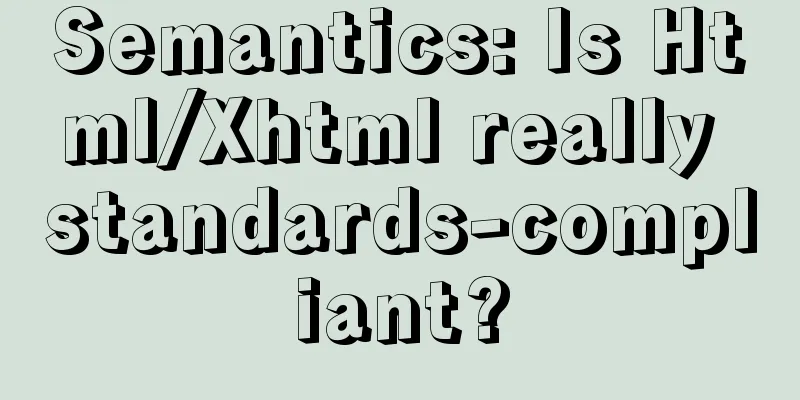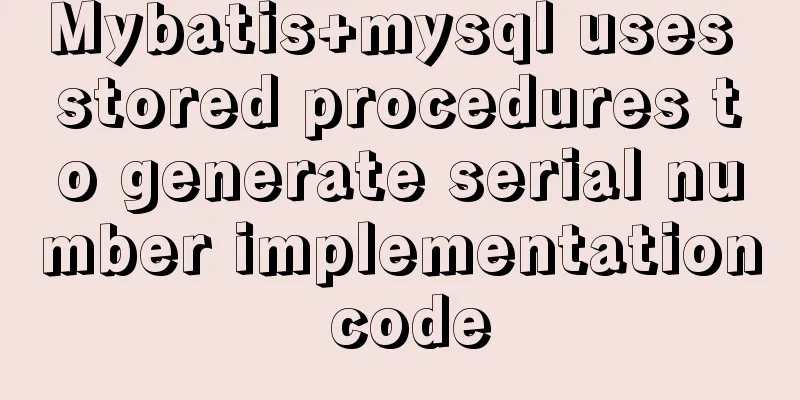Detailed explanation of the use of MySQL select cache mechanism

|
MySQL Query Cache is on by default. To some extent, it can improve the query effect, but it may not be the best solution. If there are a lot of modifications and queries, the cache failure caused by the modifications will cause a lot of overhead to the server. You can control the cache switch through query_cache_type [0 (OFF) 1 (ON) 2 (DEMAND)]. It should be noted that MySQL query cache is case sensitive, because the query cache is mapped in memory with a HASH structure. The basis of the HASH algorithm is the characters that make up the SQL statement, so any change to the SQL statement will be re-cached. This is also the reason why SQL statement writing standards should be established in project development. 1. When to cache a) The mysql query cache content is the result set of select. The cache uses the complete SQL string as the key and is case-sensitive, space-sensitive, etc. That is, the two SQL statements must be completely consistent to result in a cache hit. b) The prepared statement will never cache the result, even if the parameters are exactly the same. It is said that it will be improved after 5.1. c) If the where condition contains certain functions, they will never be cached, such as current_date, now, etc. d) If functions like date return data in hours or days, it is best to calculate it first and then pass it in. e) A result set that is too large will not be cached (< query_cache_limit) 2. When to invalidate a) Once any row of table data is modified, all caches related to the table will become invalid immediately. b) Why not be smarter and determine whether the modified content is cache content? Because analyzing cache contents is so complex, the server needs to pursue maximum performance. 3. Performance a) Cache may not always improve performance in all situations When there are a large number of queries and a large number of modifications, the cache mechanism may cause performance degradation. Because each modification will cause the system to perform cache invalidation operations, resulting in considerable overhead. In addition, access to the system cache is controlled by a single global lock, and a large number of queries will be blocked until the lock is released. So don't simply assume that setting up cache will definitely lead to performance improvements. b) Large result sets will not be cached. A result set that is too large will not be cached, but MySQL does not know the length of the result set in advance, so it can only wait until the cache is added to the critical value query_cache_limit after the reset set, and then simply discard the cache. This is not an efficient operation. If Qcache_not_cached in mysql status is too large, you can explicitly add SQL_NO_CACHE control to the SQL with potential large result sets. 4. Memory pool usage MySQL query cache uses memory pool technology to manage memory release and allocation by itself instead of through the operating system. The basic unit used by the memory pool is a variable-length block, and a result set cache strings these blocks together through a linked list. Because when storing the result set, you don't know how big the result set will eventually be. The minimum length of a block is query_cache_min_res_unit, and the last block of a resultset will perform a trim operation. Query Cache plays a very important role in improving database performance. The setup is also very simple, just two lines need to be written in the configuration file: query_cache_type and query_cache _size, and MySQL's query cache is very fast! And once a hit is found, it is sent directly to the client, saving a lot of CPU time. Of course, non-SELECT statements have an impact on the cache and may cause the data in the cache to expire. Partial table modification caused by an UPDATE statement will invalidate all buffered data for the table, which is a measure that MySQL does not take in order to balance performance. Because, if each UPDATE needs to check the modified data and then withdraw part of the buffer, the complexity of the code will increase. query_cache_type 0 means no cache is used, 1 means cache is used, and 2 means it is used as needed. Setting 1 means that buffering is always effective. If buffering is not needed, you need to use the following statement: The code is as follows SELECT SQL_NO_CACHE * FROM my_table WHERE ... If it is set to 2, you need to enable buffering, you can use the following statement: The code is as follows SELECT SQL_CACHE * FROM my_table WHERE ... Use SHOW STATUS to view the buffer status: The code is as follows mysql> show status like 'Qca%'; +-------------------------+----------+ | Variable_name | Value | +-------------------------+----------+ | Qcache_queries_in_cache | 8 | | Qcache_inserts | 545875 | | Qcache_hits | 83951 | | Qcache_lowmem_prunes | 0 | | Qcache_not_cached | 2343256 | | Qcache_free_memory | 33508248 | | Qcache_free_blocks | 1 | | Qcache_total_blocks | 18 | +-------------------------+----------+ 8 rows in set (0.00 sec) If you need to calculate the hit rate, you need to know how many SELECT statements the server executed: The code is as follows mysql> show status like 'Com_sel%'; +---------------+---------+ | Variable_name | Value | +---------------+---------+ | Com_select | 2889628 | +---------------+---------+ 1 row in set (0.01 sec) In this case, MySQL hit 83,951 of the 2,889,628 queries, and only 545,875 were INSERT statements. Therefore, the sum of the two is far from the total query of 2.8 million, so we know that the buffer type used in this example is 2. In the example of type 1, the value of Qcache_hits will be much larger than Com_select The above is the full content of this article. I hope it will be helpful for everyone’s study. I also hope that everyone will support 123WORDPRESS.COM. You may also be interested in:
|
<<: Detailed explanation of how to upgrade software package versions under Linux
>>: Practical record of vue using echarts word cloud chart
Recommend
Solution to the problem that MySql always pops up the mySqlInstallerConsole window
MySql always pops up a MySQLInstallerConsole.exe ...
Detailed explanation of creating a data table in MySQL and establishing primary and foreign key relationships
Preface When creating a primary and foreign key f...
Detailed explanation of vuex persistence in practical application of vue
Table of contents vuex persistence Summarize vuex...
MySQL's conceptual understanding of various locks
Optimistic Locking Optimistic locking is mostly i...
How to correctly modify the ROOT password in MySql8.0 and above versions
Deployment environment: Installation version red ...
Let's talk about the Vue life cycle in detail
Table of contents Preface 1. Life cycle in Vue2 I...
How to solve the problem of not getting form value after submitting html form input using disabled
After the form input box input is set to the disa...
How to authorize remote connections in MySQL in Linux
Note: Other machines (IP) cannot connect to the M...
Vuex combines session storage data to solve the problem of data loss when refreshing the page
Table of contents Preface 1. Reasons: 2. Solution...
HTML uses canvas to implement bullet screen function
Introduction Recently, I needed to make a barrage...
How to run py files directly in linux
1. First create the file (cd to the directory whe...
Analysis of Hyper-V installation CentOS 8 problem
CentOS 8 has been released for a long time. As so...
HTML background image and background color_PowerNode Java Academy
1. HTML Image <img> 1. The <img> tag ...
Vue implements div wheel zooming in and out
Implement div wheel zooming in and out in Vue pro...
Ubuntu installation graphics driver and cuda tutorial
Table of contents 1. Uninstall the original drive...









